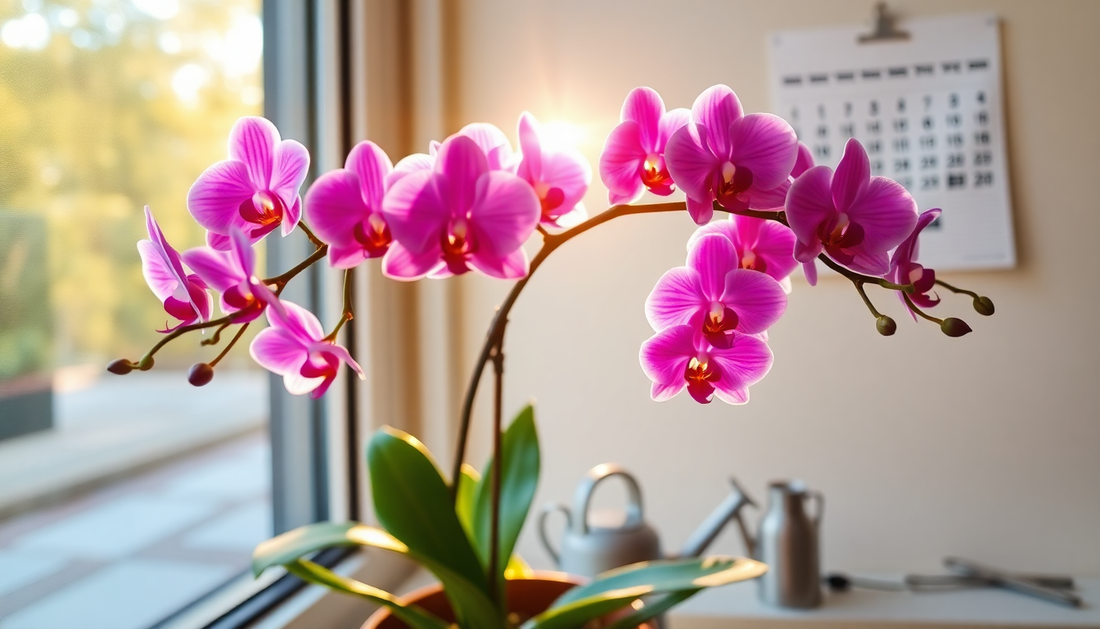
Caring for Indoor Orchids: A Year-Round Guide
Share
Orchids are some of the most beautiful and captivating indoor plants you can grow. With their delicate blooms and exotic appearance, they can add a touch of elegance and sophistication to any living space. However, many people are hesitant to bring orchids into their homes, fearing they are too difficult to care for.
In reality, with the right knowledge and a little bit of attention, orchids can thrive indoors year-round. At Idyl, our online plant shop serving the Bangalore area, we're passionate about helping our customers discover the joys of growing orchids. In this comprehensive guide, we'll share our top tips for caring for indoor orchids and keeping them healthy and blooming throughout the seasons.
Understanding Orchid Needs
Orchids are unique plants with specific requirements when it comes to light, temperature, humidity, and watering. Knowing the basics of orchid care is the first step to successfully growing these beautiful flowers indoors.
Lighting Needs
Orchids require bright, indirect light to thrive. They do best in east- or west-facing windows where they can receive several hours of sunlight each day. Avoid placing orchids in direct sunlight, as this can scorch their delicate leaves and flowers.
If you don't have a suitable window in your home, you can supplement with artificial lighting. Look for grow lights designed specifically for orchids, and aim to provide them with 12-14 hours of light per day.
Temperature and Humidity
Orchids prefer a relatively cool environment, with daytime temperatures between 65-85°F (18-29°C) and nighttime temperatures around 55-65°F (13-18°C). Sudden temperature changes can stress the plants, so try to maintain a consistent temperature.
Orchids also thrive in humid conditions, with an ideal humidity level of 40-60%. If the air in your home is dry, you can increase humidity by misting the plants regularly, using a pebble tray, or running a humidifier nearby.
Watering Requirements
Proper watering is one of the most crucial aspects of orchid care. Orchids have unique root systems that require a delicate balance of moisture and air circulation.
As a general rule, water your orchids once a week, allowing the potting mix to dry out slightly between waterings. Avoid letting the roots sit in water, as this can lead to root rot. When watering, use room-temperature filtered or distilled water, and be sure to thoroughly soak the roots.
Seasonal Orchid Care
Caring for orchids is a year-round endeavor, as their needs change with the seasons. By adjusting your care routine accordingly, you can help your orchids thrive and bloom consistently.
Spring and Summer
As the weather warms up, your orchids will begin to actively grow and produce new leaves and flower spikes. During this time, increase watering and fertilization to support the plant's increased growth.
Fertilize your orchids every two weeks with a balanced, water-soluble orchid fertilizer. This will provide the necessary nutrients for healthy growth and vibrant blooms.
Additionally, you may need to increase the humidity around your orchids as the air becomes drier. Misting the plants regularly or using a pebble tray can help maintain the ideal humidity levels.
Fall and Winter
As the days grow shorter and the temperatures drop, your orchids will enter a resting phase. During this time, you'll need to adjust your care routine to accommodate the plant's changing needs.
Reduce watering and fertilization, as the orchids will be less active and require fewer nutrients. Water only when the potting mix has partially dried out, and use a more diluted fertilizer solution.
Maintain the cooler nighttime temperatures, as this helps trigger the formation of flower spikes. However, be mindful of sudden temperature drops, as this can stress the plants.
Repotting and Dividing Orchids
Orchids typically need to be repotted every 2-3 years, as their roots will eventually outgrow the container. The best time to repot is in the spring, when the plant is actively growing.
When repotting, choose a pot that is only slightly larger than the current one, as orchids prefer to be slightly root-bound. Use a well-draining orchid potting mix, and be gentle when handling the delicate roots.
If your orchid has multiple growths, you may also consider dividing it. This can help rejuvenate the plant and encourage more blooms. Divide the orchid in the spring, taking care to ensure each division has a healthy root system and at least one growth point.
Troubleshooting Common Issues
Even with the best care, orchids can sometimes encounter problems. Here are some common issues and how to address them:
Yellowing or Wilting Leaves
This can be a sign of overwatering, underwatering, or insufficient light. Adjust your watering and lighting practices accordingly.
Flower Buds Falling Off
Bud drop can be caused by temperature fluctuations, low humidity, or stress. Ensure your orchid is in a stable environment and maintain proper humidity levels.
Pests and Diseases
Orchids can be susceptible to pests like aphids, mealybugs, and scale insects. They may also develop fungal or bacterial diseases. Inspect your plants regularly and treat any issues promptly.
By understanding the unique needs of orchids and adjusting your care routine throughout the year, you can enjoy the beauty of these stunning flowers in your home for years to come. At Idyl, we're here to support you on your orchid-growing journey. Browse our selection of healthy, high-quality orchids and explore our gardening services to help your indoor oasis thrive.
